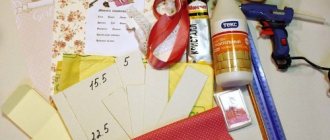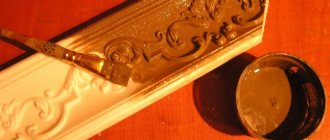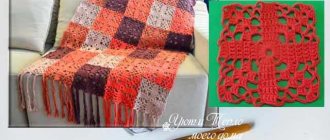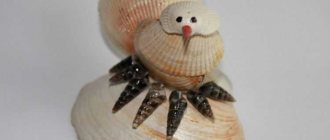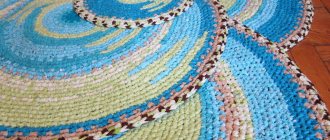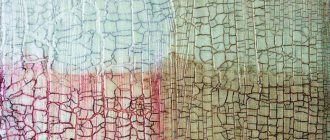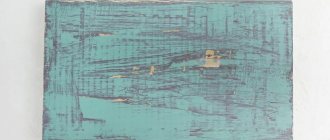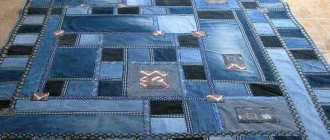Making products from twine is a newfangled trend in needlework. The material is used for both small and large crafts. Jute is used to weave stylish rugs and beautiful boxes - spectacular and inexpensive products that decorate the house, maintaining a rustic style and Provence. You can buy jute rugs or knit them yourself.
A cute little thing that is not difficult to make from jute with your own hands is a box.
You can store jewelry, memorabilia and trinkets that are simply dear to a woman’s heart in it.
Creative people are always interested in new directions, for example, various decorative elements, boxes, figurines, baskets and much more can be made from twine. Jewelry boxes made of jute and other small items are very popular.
A beautiful round box made of jute filigree technique will be a wonderful gift for family and friends.
To learn how to crochet a box, you need to read the detailed instructions for making it. With minimal cost and effort, the technology allows you to produce an original product.
The box can also serve as a decorative element for your own boudoir.
Jute is a magical material, you can make almost anything from it.
Peculiarities
Jute filigree is usually made up of extraordinary patterns in the form of the letters “C” and “S”, and the empty space of the jute box is complemented with the help of snails and the figure eight, the infinity sign.
Articles on the topic (click to view)
- Chintz: what kind of fabric is it, pros and cons, application
- Textiles in the interior
- Photo curtain for the kitchen
- Kitchen interior with black and white curtains
- Photos of beautiful curtains with eyelets
- Photo of voile curtains for the kitchen or living room
- Photo of a bedroom interior with beige curtains
Beginning needlewomen will be able to master the basics of weaving by thoroughly studying diagrams, drawings, stencils and sketches.
Ease of use and accessibility doubly attract novice needlewomen to master the technique of jute filigree.
The originality of the technology
Previously, craftsmen made amazing openwork things from strips of metal. This technique was called filigree. The ancestor of the word itself is the Greek language. It translates as “twist, twist.”
The Old Russian verb “skat” was similar to it, which is why in Russian filigree is called “scan”.
But even simple twine will allow you to create fantastic patterns; you will need to show patience and perseverance. Filigree is obtained only from jute. The threads are twisted and twisted together, forming an airy pattern. Glue is used for fastening.
They either take ready-made sketches or come up with them themselves if they have some experience in this direction. Having chosen a pattern, prepare a stencil and transfer it to the surface.
There are two ways to perform the ornament:
- Coating the outline of the drawing. Even beginners can handle this.
- Coating both the pattern and the thread.
- Small sections of the rope are impregnated with glue so that it does not dry out quickly. Then they begin to form pre-thought-out elements. In this case, the main thing is speed. If the jute is dry, then apply an adhesive composition. Using a regular toothpick, the glue is leveled on a previously prepared sketch, and the elements are applied using tweezers. The patterns are made using an awl.
When the work is finished, they begin to dry the product. Objects that do not have volume are placed under something heavy for 6 hours, making sure to place boards between them. Bulk ones are left to dry without any equipment.
Then the product is cleaned of excess glue. Using a stationery knife, carefully get rid of large residues, and use a heated knitting needle between patterns.
The finished item is coated with acrylic varnish for durability. If the product consisted of several parts, then they are all put together and then decorated with beads, seed beads, and marbles.
Manufacturing technique
To make a jute box, you need the following set of materials:
- leg-split;
- office glue and scissors;
- cardboard blank;
- wooden skewers;
- decorative elements;
- tweezers.
All materials are available and inexpensive. The manufacturing process itself is as follows.
- First, we prepare a suitable cardboard base - you will need a cardboard ring (you can take it from used wide tape, 9 centimeters in diameter).
- We glue sketches of the future box to it (you can look up ideas on the Internet or come up with them yourself).
- Wrap the twine tightly around the cardboard template. Apply glue to the inner surface. We tightly glue the turns of twine over the entire surface, as well as onto the sides of the future box.
- We leave the prepared product to dry, after which we clean the film and remaining glue with a stationery knife.
The box is almost ready, but in order for the round jute box to transform into a turtle box, some decorative elements and a little patience are needed.
The bottom of the box can be fabulously decorated using openwork technique. We draw a circle with a compass, similar to the diameter of the cylinder, and, lubricating it with glue, carefully and slowly make curls, gluing them tightly together. Let it dry.
The bottom of the box is formed by evenly laying the twine on the sides. The thread is placed directly on the glue and pulled out in one direction clockwise until the space is completely filled.
Expert opinion
Smirnova Ekaterina Anatolevna
7 years of experience in interior design, professional architect
It's time to make the lid of the box. Everything is simple here: we lubricate the surface of the pre-prepared base with glue, and use twine to depict turns and ornaments of any complexity. Let it dry.
From a round box you can easily make a turtle-shaped box with your own hands by adding legs and a shell. As for the shell, you need to work hard, namely, paste the shell with identical buttons, preferably green.
Use small buttons, or better yet, beads to mark the border between the body and the shell. In the same way we fill the gaps of the box lid.
Since the tortoise shell is convex, before pasting it with buttons and beads, you should cut a piece of foam plastic in a semicircle with a stationery knife, glue it to the lid of the box and wait until the glue dries.
Using two white buttons we attach the eyes to the turtle. Instead of buttons, you can choose any other elements to your taste. Separately glue the neck and head of the turtle to the body. The lid of the box can simply be removed or a fastening mechanism can be mounted using small door hinges.
Jute filigree for beginners: pattern diagrams and stencils
Without a pre-drawn pattern and stencil, it is difficult to form the necessary curls. Therefore, before you start manufacturing, you need to come up with or take ready-made ornaments by sketching them on paper.
For convenience, take A4 paper and put it into a multi-fork of the same size. It allows you to secure the patterns well, does not move or wrinkle.
To create a stencil, they stock up on imagination and components in the form of:
- clean paper;
- pencil and felt-tip pen;
- eraser.
Conditions for creating a stencil:
- I don’t have my own ideas, books or the Internet will help. Knowing the basic elements, it won’t be difficult to come up with your own sketch in the future.
- For beginners, it is better to draw patterns with a pencil and correct them by removing unnecessary elements with an eraser. The finished drawing is outlined using a felt-tip pen.
- If the future jute structure is voluminous with one thread, the pattern must have sufficient density for the product to be durable. When using jute ribbons, you can give the openwork more airiness, since the product will be rigid.
- The lines of the pattern should be bold so that the stencil is clearly visible through the film.
- When drawing up a drawing, it is necessary to take into account symmetry, but you can stick to your idea so that everything looks harmonious.
If you can’t draw your stencil the first time, then don’t despair, a little practice and the template is ready.
Tips for Beginners
- There should be no gaps in the cardboard; the work must be done carefully.
- Drawings and ornaments can be drawn, but it’s easier to print them from the Internet.
- The jute must be new, not old, stale, so that it does not tear during weaving and winding.
- All elements must be tightly fixed with glue. Then you should wait for the glue to dry completely.
As stated above, filigree is a jewelry work, so take enough time, work slowly, while enjoying the work done. Before you start weaving a box, you should prepare all the materials in advance. And of course, an enthusiastic approach is important. Something you can’t do without.
Hanging decorations
These include Christmas wreaths, decorative rings and openwork balls. The latter are the easiest to manufacture. The base for them is a balloon, inflated to the required size and tied very tightly.
It is wrapped with twine, which is not only glued together at the joints, but also treated with PVA in several layers over the entire surface. After drying, the balls can be painted or left natural color.
When coated with varnish, they will have a matte shine (it will also add strength to the craft). At the end of all these manipulations, the ball can be deflated or burst, and its remains can be removed from the product. Such openwork balls can be further decorated and hung on a jute thread or burlap ribbon.
Decorative rings are hung both as panels on the wall and as a design element freely located in the space of the room. Their design can be abstract, sometimes even abstract, or correspond to the theme of a holiday.
The cardboard or wooden base is wrapped with twine or burlap tape (it is also possible to cover it with a whole cloth). Details corresponding to the design theme are made of jute, burlap or elements combining various materials. Rings are hung in the same way as balls.
Interior decoration
The turtle is a symbol of nobility and prosperity, and therefore a box in the shape of a turtle, made by yourself, will become a priceless gift that can fit into any interior.
In addition to aesthetic pleasure, needlework and twine weaving is a stream of positive and inspiring energy.
Jute weaving is limitless - by twisting, the miracle thread can become not only a box, but also any other practical piece of furniture. It could be:
- interesting panel;
- vase;
- frame;
- souvenirs and Christmas tree toys;
- functional shelves;
- Wall Clock;
- candlesticks;
- interior partitions;
- flowerpots and swings;
- jute baskets (for plants, linen);
- chandelier;
- kitchen attributes;
- jewelry (bracelets, earrings).
Jute gives a certain comfort and charm to the home interior and bathroom. They can not only make what you want, but also use them as simple parts to decorate furniture, mirrors, and wall clocks.
Handicrafts in general have a beneficial effect on the psyche and make a person resistant to stress. During needlework, points on the palms and fingers that are responsible for certain organs are constantly massaged. And natural materials such as jute have an even more positive effect.
In addition to beautiful things made with one’s own hands, a person is also enriched spiritually. So, where there is beauty, there is health.
How to make a jute box, see below.
What to crochet from jute, video tutorials
Crochet jute mitten
My loofah is shaped like an exfoliating mitten. I crocheted a washcloth for a large man's palm, because... it was an attachment to a gift for February 23rd. Using the same principle, a washcloth and mitten can be crocheted to any size. In the video tutorial I crochet number 4.
The video should load here, please wait or refresh the page.
Crocheted openwork napkin LEAF from jute
This napkin can be used not only in the kitchen, in the dining room, as a table setting, but also as an eco-friendly washcloth! I crocheted from two-strand jute with crochet size 4mm.
The video should load here, please wait or refresh the page.
We crochet a simple jute basket part 1
The jute basket is crocheted without using rope. The bottom of the basket is a perfect circle. I knit with the simplest single crochets. Even a novice master can handle it.
In the first part we will tie the bottom, and in the second part we will tie the walls of the basket.
To knit a basket you will need the following materials:
- double-strand jute;
- hooks No. 4,5 and 6.
The diameter of the bottom is 14 cm, the height of the basket is 8 cm, the jute consumption is approximately 100 g.
The video should load here, please wait or refresh the page.
We crochet a simple jute basket part 2
The video should load here, please wait or refresh the page.
We crochet a jute bag, part 1
My jute summer bag is made from 8 crocheted granny squares. The bag is small in size and very easy to knit! The highlight of the bag lies in the contrasting strapping and embossed handles.
If desired, you can attach a knitted long handle or belt.
Dimensions of my jute bag:
- width - 22 cm
- height - 23 cm
- thickness - 7 cm.
To knit a bag you will need the following materials:
- double-strand jute (width 2 mm, composition 100% jute);
- black yarn Pekhorka Spring (100% cotton, 250m/100g);
- hooks No. 3.5, 4, 4.5 and 6 mm;
- carabiner rings and lining.
The video should load here, please wait or refresh the page.
We crochet a jute bag, part 2
The video should load here, please wait or refresh the page.
How to make a jute box with your own hands?
Making products from twine is a newfangled trend in needlework. The material is used for both small and large crafts.
Jute is used to weave stylish rugs and beautiful boxes - spectacular and inexpensive products that decorate the house, maintaining a rustic style and Provence. You can buy jute rugs or knit them yourself.
A cute little thing that is not difficult to make from jute with your own hands is a box.
You can store jewelry, memorabilia and trinkets that are simply dear to a woman’s heart in it.
Creative people are always interested in new directions, for example, various decorative elements, boxes, figurines, baskets and much more can be made from twine. Jewelry boxes made of jute and other small items are very popular.
A beautiful round box made of jute filigree technique will be a wonderful gift for family and friends.
To learn how to crochet a box, you need to read the detailed instructions for making it. With minimal cost and effort, the technology allows you to produce an original product.
The box can also serve as a decorative element for your own boudoir.
Jute is a magical material, you can make almost anything from it.
Crochet jute thread box
Materials:
- cardboard base in the shape of a cylinder;
- jute thread;
- wood beads;
- hook;
- sheets of cardboard;
- silicone glue.
The amount of material depends on what size you want to make the product.
A wicker jute box will help you and delight you for a long time.
Execution technique
First of all we make the bottom. You need to draw a pencil along the inside of the cylinder and cut out the resulting circle. You need to leave approximately 5 mm in reserve. We make cuts along the contour and glue the bottom for the workpiece. We put another circle on top of it and secure it with glue.
This box will decorate any home or become a pleasant gift for friends or colleagues.
The jute rope needs to be twisted into a spiral. Fixing it with glue, screw it on, completely filling the bottom area.
Wraps the side of the workpiece in the same way.
The work is done carefully so that there are no gaps in the cardboard.
Jute filigree is becoming very popular among needlewomen.
Expert opinion
Smirnova Ekaterina Anatolevna
7 years of experience in interior design, professional architect
Using a hook, you need to knit chains of air loops. Its length is equal to the circumference of the cylinder. The lid is made in the same way as the bottom of the product. You can crochet it.
Interior items made using filigree technique from jute cord fit harmoniously into the interior and can become a beautiful and expensive gift.
We cast on 2 air loops, and in the 3rd - 12 columns, then the number of loops needs to be doubled. Third row - knit 36 loops. We continue to perform the next two rows with 36 loops each. This way you will get a knitted lid for the box. We stretch ropes from the front side and attach wooden beads to them. We tie the ends into bows.
Considering the availability of jute, the main material for such creativity, absolutely everyone can master the technique of jute filigree.
You can draw a drawing on paper and work from the drawing, or you can immediately lay out the drawing in a frame.
Lid
Now let's start making a lid for the box from jute thread.
Draw a circle slightly larger than the diameter of the box. The design of the lid will be slightly curved, and due to this it will slightly decrease in diameter to the desired size.
In the center of the circle we place a pattern of six petals (loops). Draw the details inside each petal.
We lay out the design from jute.
Let it dry a little, and then bend the petals slightly. You can use some suitable spherical shape for this, or you can gently bend it with your hands.
In order for the lid to fit well on the box, we will make a flat platform. This ring is 4-5 turns of jute wide. Glue it to the edge of the lid from the wrong side.
And so that the lid not only fits well on the box, but also does not roll off it, we will make a persistent ring on the inside. Glue it along the circumference with an edge to the flat ring on the lid.
Having finished work on the design of our lid, we will begin to decorate it.
The decor will consist of the same beads and six small volumetric leaves.
We make leaves on a plane. First we glue the outline, then fill it inside. Remove from the surface, cut off the glue. We bend the leaf with our hands, give it the desired shape and glue it to the lid.
We make the top of the lid for the jute cord box from a large wooden bead. We glue it in the center of the composition, thereby completing our work on the box.
0 Comments
Box made of jute filigree technique
Basically, a cord of natural color is used for work, but for multi-colored work it is painted with acrylic paint. Also, to obtain white jute cord without dyeing, it is soaked in chlorine. The technique involves creating openwork patterns from jute twine.
Do you agree that there is often a moment when there is nowhere to put the next decoration? I propose to make a box with your own hands from jute twine using stationery tape.
For work we will need:
- jute twine (cord)
- Titanium glue, or any other transparent glue.
Attention! It is necessary to work in a well-ventilated area, as the glue smells very strongly!
Stage 1. Take a piece of squared paper, put some tape on it and draw it around it.
Stage 2. Mark the center of the resulting circle. Insert the sheet into the file.
Stage 3. Apply glue to the middle of the file.
Stage 4. We start by twisting the curl.
Stage 5. Consistently fill the entire circle. Two such circles are needed. The first will serve as the bottom of the box, the second as its lid.
Stage 6. After we have filled the circle (the bottom of the future box), we do not cut the thread.
Stage 8. Glue the pattern to the tape in a circle. You need to glue it with tape yourself.
Stage 9. We place adhesive tape with a pattern on the bottom of the future box, coat it with glue and wind several rows to the pattern. Thus, we connect the bottom with the future box.
Stage 10. We cut the thread and wind several rows on top, as if creating headbands.
Stage 11. Coat the first curl on the pattern with glue, cut off a piece of twine (cut the ends diagonally). The pieces of twine should be of different lengths depending on the curl being laid out.
Stage 12. We lay curl after curl along the glue trail.
So, curl by curl, we lay out the entire pattern.
Important! So that the upper and lower patterns are glued flush to the rims. After the entire pattern is laid out, we leave the box to dry for a day. After drying, carefully separate the box from the tape with a stationery knife. So we walk around and take out the tape.
Stage 13. We make the lid in the same way as the bottom of the box. We again apply the tape to the workpiece and make a few turns around it.
We decorate the top of the lid with additional patterns.
We decorate the jute box with decorative elements.
The final stage. We treat the box with PVA glue diluted with water. We remove the remaining glue on the patterns with a hot awl.
Decorative plate
Take any salad bowl you like, cover it with film, secure it and start gluing it with curls, starting from the bottom of the plate. Curls can be placed arbitrarily, trying to maintain symmetry, or you can use any designs you like.
Tools – scissors, glue and knitting needle.
There is no need to immediately cut off a piece of thread. First put the drawing, then carefully cut and glue with small scissors. The film is well suited for this, as the rope adheres perfectly to it.
The most basic elements of this style are curls and loops; their alternation produces beautiful patterns.
Attention! We must try not to twist the thread and lay it as it unwinds from the skein. Otherwise, it may unravel after painting. You need to work with glue more carefully so that there is not too much of it.
Lay the patterns as you want, so that they are laid more often and densely.
Then you need to separate the pattern from the film with a sharp knife and wipe off the glue. Glue with diluted PVA and paint if desired. You can use a spray can or a brush.
The result is a plate, as in the photo.
Design options
Before you start making a box, you need to decide on its design. Here are the most interesting options.
- If you are just starting to get acquainted with a new type of creativity, choose simple options. These are boxes of rectangular, round or square shape. Avoid weaving complex volumetric elements in favor of a minimalist design. Once you are confident in making these crafts, you can move on to the next level of crafts.
- When making crafts to decorate a room in a retro style, pay attention to the “Nostalgia” style . A light openwork and round box will fit perfectly into the interior.
- Models with flowers and plant elements are the best choice for Provence style . One of the main characteristics of this trend is the plant motif. A heart-shaped product would also be great. You can decorate the products with beads, lace or ribbons.
- For a country , choose boxes with other decorative elements made of wood and even metal.
- If you want to decorate a child’s room with a handmade product using flexible jute, you can give the box any shape (bunny, kitten, butterfly and other options).
Decorative animals
Designer figurines of cats, bunnies, dogs, owls and foxes, designed for interior decoration, delight handmade lovers young and old. Their popularity among handmade crafts made from jute twine can be considered the highest. Despite the fact that they generally have no utilitarian value, they are happily made as gifts, souvenirs and competition entries.
This technique is based on spiral wrapping. The body of the animal is formed from a bottle (torso) and a foam ball (head). They are covered, row by row, with thread, which does not need to be glued along its entire length. The tail and paws can be crocheted and starched for strength, or made from wire wrapped in jute.
Ears and wings are good either knitted or glued using a technology similar to making hot coasters. Eyes made from beads, buttons, coffee beans or peas are just as expressive as those bought in a specialty store (owl eyes can easily be made from threads of the same jute, tied onto a narrow ring and fluffed at the ends).
Cereals, grains, beans, dry blades of grass and spikelets, pine cones, beads, ribbons, bows and flowers (ready-made or made with your own hands from scrap materials) can be used to decorate the figurine. All these parts can be glued to the body using hot glue.
Artists who have achieved the heights of skill in working with these materials decorate products with amazing filigree elements made using other materials and techniques. Openwork details transform modest animals into fairy-tale characters, adding magical notes to the design of the room.
Tools and materials
When making crafts, you may need the following.
- Jute (twine).
- Rough burlap material.
- Sharp scissors.
- Threads and needles.
- Sewing centimeter and ruler.
- Various templates and stencils made of cardboard.
- Frame of a future craft.
- Decorative elements: lace, beads, rhinestones and much more.
- Adhesive composition.
Note: For beginners, it is better to prepare sketches of finished products for visual reference. The list of necessary tools and materials will differ depending on the chosen master class.
Kitchen Tricks
It is not for nothing that jute is considered an environmentally friendly material. Not only due to its natural, plant origin, but also due to its appearance. The natural color of the fibers, which has warm shades, gives the product a look that corresponds in the mind to the concepts of “traditional”, “folk”, associated with comfort and peace.
An ordinary glass jar or coffee tin, tightly wrapped in jute, will become not just a decorated container for storing bulk products, but also an element of interior design.
Complete the design with a thin strip of lace, beads, flowers made from ribbons, or an ornament of cereals and grains - and beautiful and simple handmade twine crafts will decorate your kitchen shelves.
Original baskets for cookies and sweets are made from bowls or salad bowls covered with jute cord. The dishes are used only as a basis. To avoid getting stained with glue, wrap it in cling film or foil.
For this work, it is better to take PVA, because the thread, rolled into a spiral, must be glued along its entire length - this allows you to achieve the necessary strength and safety for further use.
The spiral can be formed either from twine itself or from a long chain crocheted from it. Depending on the design, it can be left untreated, with volume and unevenness, or steamed with an iron to make it flat, more elastic and even.
Among rope crafts, the ones that are perhaps the most simple and accessible are hot coasters. These can be ordinary dense spirals, made of a rope of one color or threads of several shades.
The diameter of the product depends on its purpose: large for a frying pan, smaller for a teapot, small for cups. This set looks wonderful on the table, and after use it can be folded into a neat stack, turning into an element of kitchen design.
For variety, the edges of the stand can be decorated by forming some kind of petals or gluing smaller spirals. You should not do this with hot glue - it will melt when it comes into contact with hot dishes.
For beginners, such crafts made with their own hands from jute are not only a creative start, but also an opportunity for self-expression, designing their living space in accordance with their tastes and interests. Even children who have barely mastered the basics of appliqué can cope with the simplest options.
Gaining confidence in the process of work, you can begin to implement more complex and labor-intensive plans, the technology of which requires both additional materials and the possession of various additional skills: crocheting, macrame, quilling, etc.
How to do it?
This master class for beginners will help you make an original craft with your own hands. During the manufacturing process, follow the instructions exactly. For work, prepare the following.
- Jute in two different colors (light and dark).
- Glue "Titan".
- Ruler or meter.
- Scissors.
- Round base (you can use a regular pan).
The step-by-step diagram will be like this. The first step is to make a circle of threads; to do this, the chosen shape is wrapped in jute 3 times and coated with glue. As soon as the composition has dried, the first element can be removed. This is what should happen. We make two such elements.
We put one of the circles on the mold (pan) and begin to glue two jute threads (strings) to it, placing them vertically, at the same distance between them (from 0.5 to 0.7 centimeters). If the gap is too large, the craft may look sloppy.
To prevent paired threads from interfering during work, you need to secure them on top with a thread.
On top of the product, at the base, glue a strip of three-strand tape, focusing on the attached photograph. Having risen a little higher, we place another such element. We repeat this step again. As a result, we got 3 rows at the same distance from each other.
As soon as the glue with which you fix the threads has dried, remove the base. Now we need a light thread. With its help we weave a seam called “goat”. To make the pattern look neat, we hide the end of the thread inside and secure it with glue. If you are not familiar with the “goat” pattern, refer to the photo and the diagram attached below.
Let's create the bottom row. We make another row on top so that it looks like in the photo.
This is what the completed row will look like. Glue two more rows of three horizontal threads.
In this case, you need to use the form again. Using the pattern described above, make 3 more rows of light twine using the goat pattern.
This is the final basis for the future box.
To secure the structure, you need to glue another strip of jute to the outside, and to the inside we attach the circle that we made at the beginning. For a neat appearance, cut the racks along the inner circle.
It is worth noting that the circle of threads on the outside should be located slightly lower than the inside, as in the picture. Now we glue another element of threads on the outside. It will already be on the same level as the inner circle.
Now we decorate the top edge, glue a ribbon of three jutes to it on top of the product. Top view of the finished edge.
Now we need to make the lid. We make a circle of three threads, taking into account the diameter of the box.
Expert opinion
Smirnova Ekaterina Anatolevna
7 years of experience in interior design, professional architect
After finishing the elements on the inside, you need to glue a few more ribbons, making 3 or 4 rows. To check the dimensions of the cover, place the product on it.
Next, from ribbons (ribbons made from threads) you need to create a mesh, as shown in the picture. Using elements of the same length, fill the entire lid.
Next, the resulting mesh needs to be trimmed in a circle, giving it the desired shape. Connect the two pieces and get a base for the lid that will look like this.
Now the mesh needs to be decorated using white jute. Select a cross pattern.
Using two ribbons, braid the edges of the finished mesh on both sides, as shown in the picture. We glue the resulting part into a circle made specifically for the lid.
Now you need to connect the two parts of the craft - you will get a nice handmade product. The junction of the bottom of the box with the base must be covered with a wide ribbon of twine.
To make the lid hold better, you can add a border to it. The original craft is ready.
It can be decorated with various decor, such as artificial flowers.
Watch the video for a master class on making a bean bag.
What to crochet from jute - photo ideas
You can knit interior baskets from jute:
Crochet jute - carpets:
Crochet from jute, what else can be crocheted:
Jute creative
Products made using a technique reminiscent of quilling look extremely interesting in any interior. In this way, amazingly beautiful products are obtained that can be called jute filigree. Their appearance, indeed, resembles forged and jewelry: openwork boxes, baskets, Easter eggs, topiaries, lanterns and much more.
The imagination of the masters never ceases to amaze! They will help transform the workplace of a seamstress, teacher, accountant, designer, artist, and decorate them with original organizers, boxes, pencil cases, needle cases, and tool stands.
You can’t count all the new twine crafts that you can make with your own hands by choosing samples suitable for a specific interior, needs and skill level! Jute and burlap are materials that continue to inspire and give new ideas.
Features and characteristics of natural jute
Jute, like twine, is a natural material that is environmentally friendly, durable, and highly wear-resistant.
Original products with an aesthetic design, made from threads, fit perfectly into interior design in ethnic, country or eco-style. With a minimum of effort, you can create unusual and practical products with your own hands that have their intended purpose. Such fascinating handicraft will not leave indifferent connoisseurs of elegant decorations that are combined with stylish home decoration and ergonomic home furnishings.
Flowerpots
Among handmade crafts made from burlap and twine, flowerpots occupy a special place, since their practical purpose does not raise questions or doubts. When making them, you should take into account the weight of the flower pot that will be placed in it, that is, calculate the safety factor in advance or take care of safety elements.
There are a lot of options for their manufacture: pasting a plastic or ceramic base, wrapping with a rope, a chain knitted from jute, or a burlap ribbon, braiding a frame, etc.
One of the most interesting techniques is to form the body of a flowerpot from a single piece of burlap soaked in PVA (you can add other strengthening substances to the mixture, for example, gypsum or cement).
The molding base must be wrapped in film and placed upside down on a flat surface. Immerse the canvas in the prepared mixture and soak it well. Then straighten and wrap it around the base. In this case, the bottom part should be neatly aligned, and beautiful voluminous folds should form along the edges.
The product is left until completely dry, then the mold is removed from it. The resulting pots are decorated with decorative elements made from twine or improvised materials, and tinted with aerosol paints.

